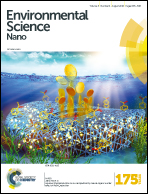Influence of structural defects of Ge-imogolite nanotubes on their toxicity towards Pseudomonas brassicacearum†
Abstract
While the definition of a nanomaterial (NM) is mainly based on size, it is known that decreasing size can induce structural modifications to compensate for increased surface energy. Nevertheless, the influence of these structural modifications on NM toxicity, and in particular structural defects, is poorly studied mainly because of the difficulty in varying the crystallinity of a NM without changing any other morphological parameters. In this study, we used a single-walled alumino-germanate nanotube (Ge-imogolite) as a model, for which this can be achieved. Differences in toxicity of well-crystallized Ge-imogolite vs. Ge-imogolite presenting vacant sites towards the soil bacteria Pseudomonas brassicacearum were studied. Well crystallized tubes led to moderate toxicity attributed to a direct contact with the bacteria and the generation of reactive oxygen species, whereas tubes presenting vacant sites caused more severe toxic effects without any direct contact nor ROS generation. The bacterial growth inhibition in the presence of lacunar tubes was attributed to indirect mechanisms as their higher solubility leads to Al or Ge toxic ion release and/or to the retention of essential nutrients on the vacancies. This study highlights the close correlation between structural defects of a nanomaterial and the modulation of its mechanisms of toxicity.


 Please wait while we load your content...
Please wait while we load your content...